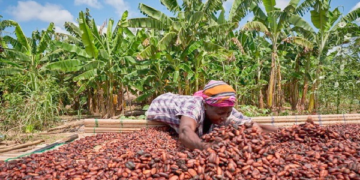Ghana’s cocoa industry, a vital source of foreign exchange, is facing a looming threat as a result of various factors, including illegal mining, mounting losses, and aggressive efforts by advanced countries to expand their own cocoa production and exports.
The Ghana Cocoa Board, responsible for overseeing cocoa production and exports in the country, is grappling with significant annual losses that have been flagged by the International Monetary Fund (IMF) as a major concern for the sector and the government’s fiscal endeavors.
According to the IMF’s report on Ghana’s extended credit facility program, COCOBOD (Ghana Cocoa Board) has been accumulating substantial annual losses over the years. These losses can be attributed to several factors, including the high cost of roll-over outstanding cocoa bills, a disparity between the purchase price paid to cocoa producers and the operational costs incurred, and the burden of quasi-fiscal activities such as providing fertilizers and developing rural roads, which have significantly increased the board’s administrative expenses.
COCOBOD in January this year defaulted on payments for maturities of its 182-day bill, rolling over outstanding securities with face value of GH¢ 940.42 million.
The government is currently engaging with investors for a restructuring of the cocoa bills.
The sector has also not been spared the harsh realitiies of illegal minners whose activities have affected cocoa production.
In February this year, it was reported that National Cocoa Rehabilitation Programme which was done at a cost of GHC 4.2 million faces threats from illegal miners who have taken over cocoa farms across the country, including farms which were recently rehabilitated.
Foreign nationals have also taken advantage of the lapsed security issues at the district levels to perpetuate huge devastation of cocoa farms in favor of mining gold.
Government efforts at fighting these menace have so far proved futile.
These challenges, coupled with some non-producing countries in Europe and Asia venturing into the production and export of cocoa poses a huge risk to the country;s cocoa sector.
Ghana earns over $ 3 billion in forex alone for the raw exports of the cocoa beans. Ghana’s cocoa commands a premium on the international market.
Competition
Ghana and Cote D’voire are facing competition from Western and far east countries, some of whom have started experimenting with cocoa production and the possibility of exports.
The decision of the top two cocoa-producing countries, Ghana and Cote d’Ivoire, to institute some aggressive measures aimed at safeguarding its cocoa industry appears not to sit well with global players, some of whom are now exploring the possibility of producing their own cocoa beans.
In 2018, Ghana and Cote d’Ivoire agreed to set a floor price for cocoa on the global commodity market, below which none of the two countries would sell its produce.
Another key action point was the adoption of a concurrent opening season and announcement of producer prices to be paid to farmers in the two countries.
In addition to this, the two countries, in 2019, also introduced the Living Income Differential (LID), which set a standard of $400 per tonne and charged on top of world prices.
The LID was introduced to guarantee cocoa farmers a minimum price that would improve the income of farmers, many of whom live in poverty.
At a recent meeting in Accra, Ghana’s Minister of Food and Agriculture reiterated that the two countries would continue to collaborate to push for good pricing on the international market
Last year, it was reported that the two countries were boycotting meetings in Brussels for the World Cocoa Foundation on cocoa sustainability because some multinational chocolate companies and traders were blocking the LID.
In what may seem like a response to these measures by the two countries that account for almost 65 per cent of global cocoa beans, China and some countries in Europe have started the production of cocoa beans.
China cocoa export
The Chinese Academy of Tropical Agricultural Sciences (CATAS), in 2021, reported that South China’s island province of Hainan had exported cocoa beans to Belgium for the first time.
The China Daily newspaper quoted Hao Zhaoyun, a researcher with CATAS as saying: “The first batch of 500kg of cocoa beans, worth $3,600, was produced in Xinglong, a township of Hainan with a tropical climate.”
Although China currently does not appear in the 45 top cocoa-producing countries in the world, many experts opined that its full entry into the cocoa export space was a potential threat to the fortunes of the two biggest cocoa-producing countries, Cote d’Ivoire and Ghana.
Their apprehension was bolstered by the application of technology in cocoa production in China.
Although COCOBOD at the time expressed concern about the development, it nevertheless said it was too early for the country to panic.
“We are concerned, but it is too early for anyone to start panicking because if you look at the quantity of cocoa that has been exported by China, it is quite small and less than one tonne.”
“We are concerned due to the fact that if production is increasing at a time when consumption in the world is not increasing, then obviously it will have an effect on the price,” the Senior Public Relations Officer (PRO) of COCOBOD, Mr Fiifi Boafo said.

































